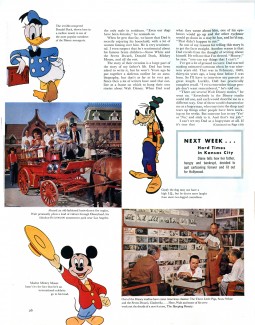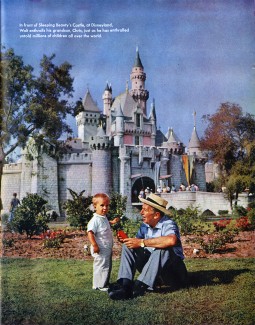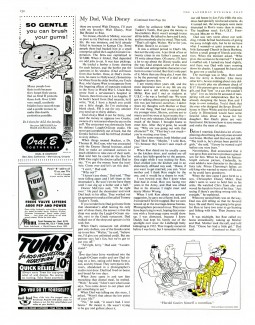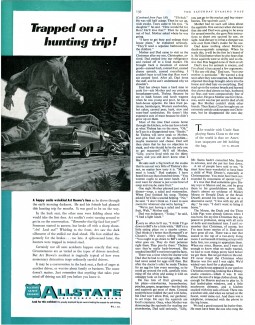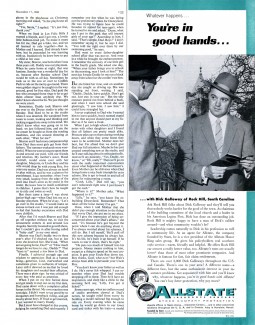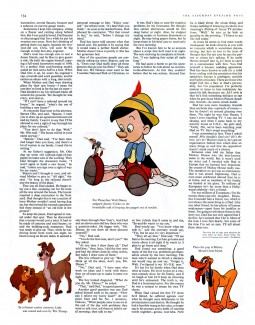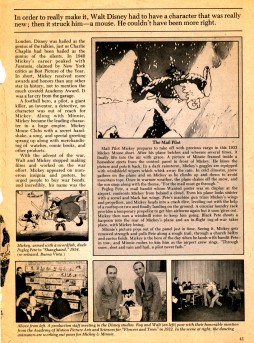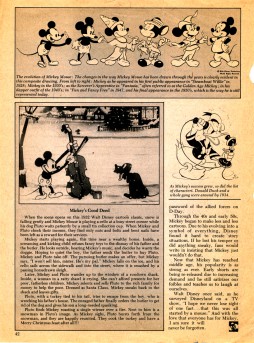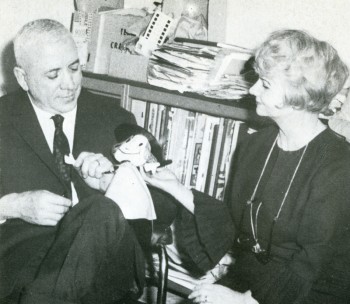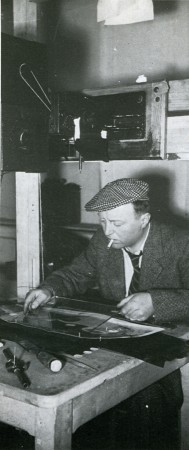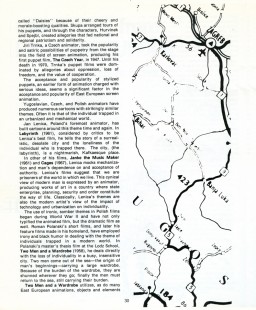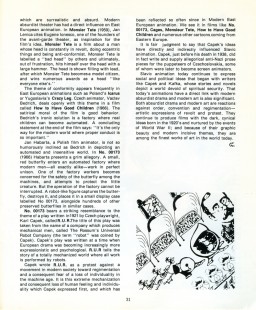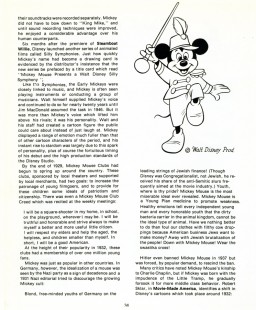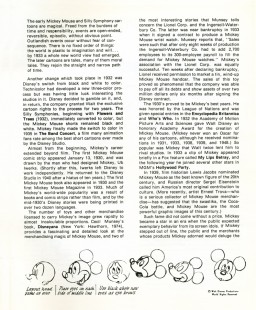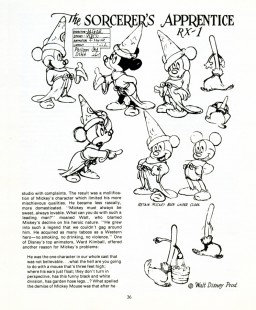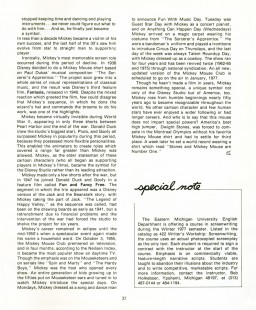Category ArchiveArticles on Animation
Animation Artifacts &Articles on Animation &Disney 05 Dec 2007 08:41 am
Dec. 5th
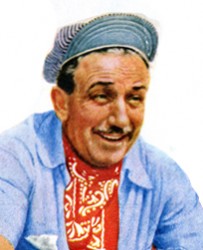 – Today’s Walt Disney‘s birthday. It’s also the second anniversary of this blog. I thought I should post something appropriate for the Disney celebration, and decided to look back some fifty-odd years.
– Today’s Walt Disney‘s birthday. It’s also the second anniversary of this blog. I thought I should post something appropriate for the Disney celebration, and decided to look back some fifty-odd years.
To a young, would-be animator, desperate to read ANYTHING about cartoons or Disney, the Saturday Evening Post offered a miraculous treat. Published in eight installments, Diane Disney Miller gave us a biography of her father. This was not something you saw elsewhere – let me tell you.
The library only offered a small handful of books on animation, and there were no biographies of ANY animator or animation producer/director. Here was the cr̬me de la cr̬me, a biography of the big guy. So I bought every one of those eight issues Рprobably using up my entire allowance for those weeks. (I was ten years old, at the time.) Then, after all eight articles were printed, the biography came out in book form. The perfect Christmas gift.
These days, publishing and marketing have gotten more sophisticated. A new animation book comes out every week, and a new film every other week. However, quantity does not mean quality, and Specials are no longer special. They were then. Things were innocent. A communist hid behind every telephone pole, and animation studios meant Disney.
So, for today, here’s that very first installment of Diane Disney Miller’s book. I’ve left it complete with ads, so you can take in the period as a whole. This book is still entertaining and worth reading, though I’d follow it up with Mike Barrier’s The Animated Man.
_
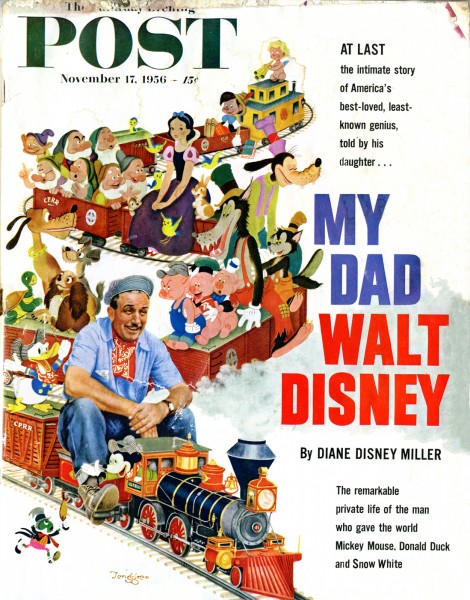
______________(Click any image to enlarge.)
Animation Artifacts &Articles on Animation &Disney 13 Oct 2007 08:00 am
Very Special Mouse
- This article came into my hands, and, unfortunately, I have no way of knowing where it was published. It apparently was published in the 50′s or early 60′s (the clue is the drawing on the last page of Mickey through the ages.)
At any rate I thought it was worth sharing. Interesting that it talks, predominantly, about Mickey in the 30′s.
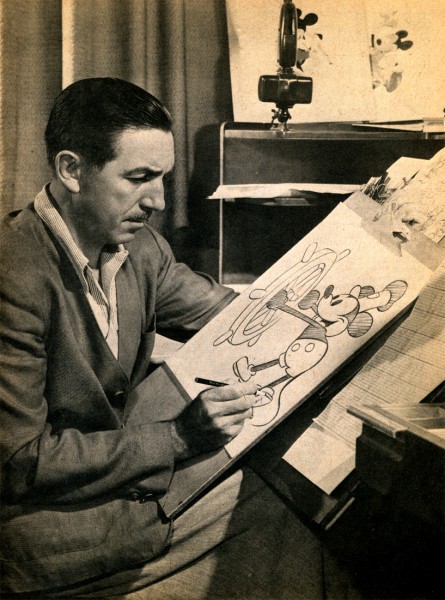
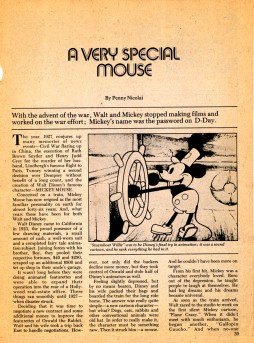 _
_ 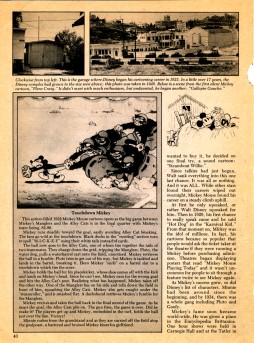
(Click any image to enlarge.)
Articles on Animation &Norshtein 04 Oct 2007 07:53 am
Norstein
- I started the day watching an interview with Yurij Norstein. It was a very inspirational 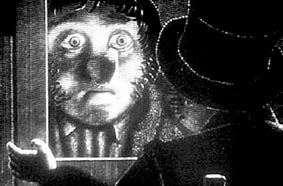 viewing for me. (As a matter of fact, this site, Animatsaya In English, is a must read for anyone interested in Russian animation – and you should be. There’s just so much to read/view on it.) But back to the interview.
viewing for me. (As a matter of fact, this site, Animatsaya In English, is a must read for anyone interested in Russian animation – and you should be. There’s just so much to read/view on it.) But back to the interview.
Norstein had just acted as a judge on the 12th Open Russian Festival of Animated Film back in March of 2007. (I assume this interview has been out there for some time.)
Some few parts of the interview really caught my attention. Here he’s asked about current films in production and their quality:
- Norstein: The very essence of animation that had been laid down in the 1950s is missing from today’s feature film. So, we cannot see too many films today of true quality.
Q: What is the essence of animation which is gone? Is it possible to formulate in words that which has gone?
N: Empathy is gone, sincerity is gone… hardship is gone. For me this is very important. Psychology is gone. The school of gesture is gone; classic gesture. In their place is discreteness, which is very quickly and easily understood, and just as quickly and easily forgotten.
That’s the essence of the problem. Isn’t it?
Then he’s asked to comment on Petrov‘s most recent film, My Love, and I think he offers an excellent answer.
- Q: … let’s begin with Petrov’s film ["My Love"]. Unfortunately the name “Petrov”, I think, the rest of the world probably knows better than we do?
N: No, he’s also known over here, of course.
… he received an Oscar for the film “The Old Man and the Sea”. Which incidentally was made in Canada, not here.
Q: There’s an unusual technique, as I understand.
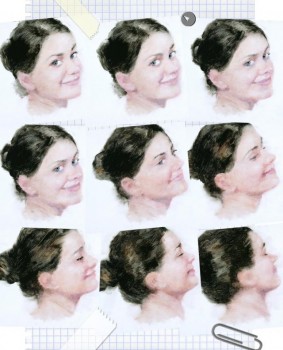 N: The technique is something. He has an unusual technique – I can’t say that he invented it, animating with paint on glass, I think it was invented by Caroline Leaf. She made the first film, in 1978. It was called “The Street” [watch the film], and it was a wonderful film in its time. Some story by a Jewish writer [Mordecai Richler], I don’t remember now, I don’t know… this was an event then. Sasha was certainly aware of this film. He wonderfully… I think that in animated filmmaking today few draw like him, and maybe nobody does. He’s a complete virtuoso in this respect. And his first film “The Cow” [see my earlier post about Petrov] was an immediate phenomenon. It was a diploma work and a full-fledged film at the same time, and incidentally was nominated for an Oscar. What’s surprising is that __________Petrov model sheet for My Love.
N: The technique is something. He has an unusual technique – I can’t say that he invented it, animating with paint on glass, I think it was invented by Caroline Leaf. She made the first film, in 1978. It was called “The Street” [watch the film], and it was a wonderful film in its time. Some story by a Jewish writer [Mordecai Richler], I don’t remember now, I don’t know… this was an event then. Sasha was certainly aware of this film. He wonderfully… I think that in animated filmmaking today few draw like him, and maybe nobody does. He’s a complete virtuoso in this respect. And his first film “The Cow” [see my earlier post about Petrov] was an immediate phenomenon. It was a diploma work and a full-fledged film at the same time, and incidentally was nominated for an Oscar. What’s surprising is that __________Petrov model sheet for My Love.
it DIDN’T win. Now that was one film which
should have won, because it was in all respects a NEW film. Of a new psychology. Well, it’s sufficient to say that it was an adaptation of Platonov, you see? This already speaks of the quality of the animation. The film which he has just made – it received the Grand Prix, and I think won another two categories… but… I should really speak with Sasha about it, because the virtuosity is the same. The same glamour. But I think there are things in cinema more important than certain moments, than a simple showcase of mastery…
Q: So basically… you wished for depth?
N: I wished for depth. I wished for… economy. I wished for, on some occasions, humility, when virtuosity gives way to something more deep, psychologically more important.
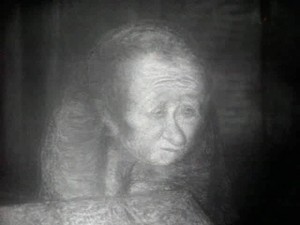 The interview also talks extensively about Norstein’s film in progress, The Overcoat.
The interview also talks extensively about Norstein’s film in progress, The Overcoat.
Apparently, this film is in full production again and a half hour should be completed this year. (The total running time will be about 65 mins.) He expects to release that 30 mins. when they’re complete.
To watch or read the full interview go here.
_
_________Norstein’s The Overcoat
Animation Artifacts &Articles on Animation &Puppet Animation 03 Oct 2007 07:31 am
Starévitch
- I’m continuing a small series of lifts from a catalogue I have which features master French animation pioneers. It was a souvenir of a 1981 Parisian exhibition on the history of French animation.
My focus here is one of the greatest stop motion animators in history, Ladislas Starévitch. I’m offering, here, a loose translation of the catalogue entry (with a couple of additions I’ve chosen to add.)
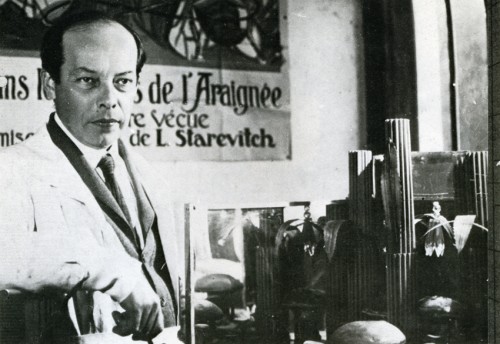
Ladislas Starévitch (1882-1965)
- Born to a Polish family living in Moscow a century ago, Starévitch was an entomologist. When the idea occurred to him to use the technique of frame by frame animation to reconstruct aninsect battle which he’d witnessed, animation entered his life. The film was titled Lucanus Cervus (1910).
So attracted to this conceit of animating his bugs, in the next few years, he made several other stop-motion films before actually beginning a full-time career in animation. This included one of his most famous films, The Revenge of a Kinematograph Cameraman in 1912. The Russian Revolution led to his emigration to France in 1919; this put a temporary halt to his filmmaking. However, a new career began in France when he started to make fiction films exclusively. Assisted by his daughter, Irene, he grew dedicated to 3D puppet filmmaking for the rest of his life.
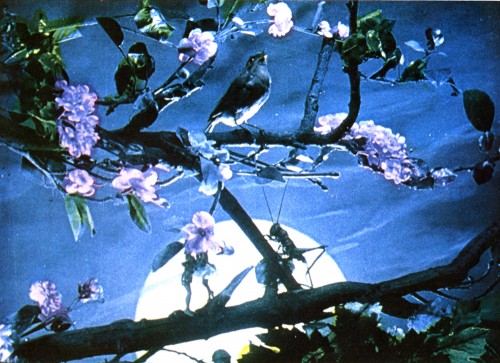
The Voice of the Nightingale (1923)
Poet and craftsman, as inventive as he was clever, Starévitch created new films including In the Spider’s Grip (1920), The Voice of the Nightingale (1923), and The Eyes of the Dragon (1925), etc. Many technical innovations came from his fertile imagination and resulted in a high level of animation.
Starévitch completed a full-length film (65 mins) entitled The Story of Fox (1930) which found distribution years later (1941) after adding sound to the feature. He lzo created a series with the dog “Fétiche” (1934) as his principal protagonist.
_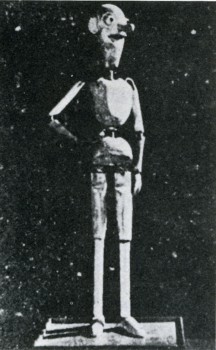 __
__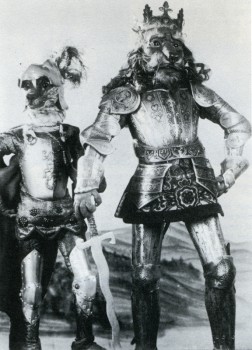
_To the left, an early Starévitch armature from the MOMA collection.
_To the right, a scene from The Story of Fox.
When I was young I had a 16mm print of The Revenge of the Kinematographic Cameraman, and I think I must have watched that print a couple of hundred times. I was absolutely intrigued with the accomplishment he had done in 1912 and felt, then, that it was on the same level as Winsor McCay’s Gertie the Dinosaur.
I’ve seen a number of his films at the Museum of Modern Art and was completely taken with his technique and craft in the film, The Magical Clock (1928) (aka The Little Girl Who Wanted to Be a Princess). The film includes some amazing combinations of Live Action with stop motion animation.
It’d be lovely if some of these films were collected for dvd release in a good quality version. Because many of these films are in public domain, there are a lot of bad, unwatchable copies out there. The official website for Starévitch includes links to some copies of films from Doriane Films including The World of Magic of Starevitch and The Story of Fox. Presumably these might be the best available.
Articles on Animation &Comic Art &Commentary &Disney &Theater 01 Oct 2007 07:55 am
Alices
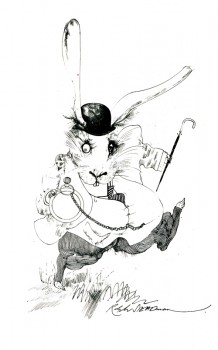 - I am a lunatic for the work of Lewis Carroll.
- I am a lunatic for the work of Lewis Carroll.
As such, naturally his Alice In Wonderland has always intrigued me. The book, itself, has inspired so many artists since it was written that we have to recognize it as a great work of art.
I think I’ve seen a dozen film versions and have seen at least four theatrical versions. I must say that some incredibly inspirational moments have come for me out of the best of these. Off the top of my head I think immediately of Alice by Robert Wilson. This was a theatrical version which dealt with the relationship between Alice and Charles Dodgson. I think of Haddock’s Eyes by David Del Tredici as performed by Tom Hulce. This was a small show that somehow touched me; I’ve thought of it often since I saw it in 1987. Or I think of David Del Tredici‘s Final Alice, a stunning piece of music. There’s the beautiful film Dreamchild, which includes some stunning puppetry by the Henson group. I think of moments from the Lou Bunin film, or even Disney’s version. I think of some of my favorite illustrated versions, led by Ralph Steadman‘s book. When I see a version on line, any version, I’m conditioned to stop.
- Nonsenselit.org features the entire comic book 1951 Unbirthday Party with Alice in Wonderland. The art is quite interesting and the layout of the comic book is certainly creative. Once they get to Wonderland, the boxed format of the traditional comic book is out the window, and the strip is more chaotic. The inking for the strip is beautifully done, and the magazine is worth viewing for that alone.
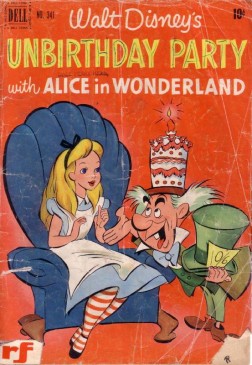 __
__ 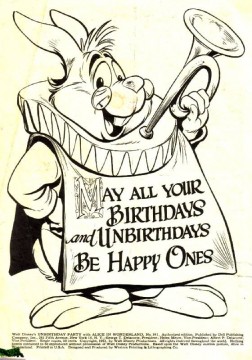
(Click any image to enlarge.)
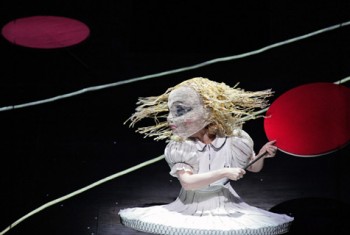 - A favorite site, the Blog of Bosh led me to the site of the Bavarian State Opera. There I found a lot of information about an operatic version of Alice which they produced in June of this year. It was written by David Henry Hwang and composed by Unsik Chin. This is obviously a creatively produced theatrical version of the story. There are many stills on the site and a stunning little video with clips from what is obviously an imaginative production. I urge you to look at the video if you have any interest in Alice or creative theatrical productions.
- A favorite site, the Blog of Bosh led me to the site of the Bavarian State Opera. There I found a lot of information about an operatic version of Alice which they produced in June of this year. It was written by David Henry Hwang and composed by Unsik Chin. This is obviously a creatively produced theatrical version of the story. There are many stills on the site and a stunning little video with clips from what is obviously an imaginative production. I urge you to look at the video if you have any interest in Alice or creative theatrical productions.
Despite the imagination and creativity on display in the video, there seems to have been some in-fighting between the composer and the designer. Some reviews have called the staging static. You can read a positive review from the LA Times which gives a full history of the show. There’s a negative review in the International Herald Tribune. I’d like to see a production for myself.
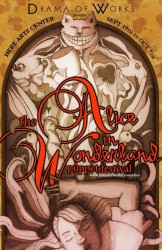 New Yorkers and puppet theater fanciers might take note of the Alice In Wonderland Puppet Festival underway at the Here Arts Center.
New Yorkers and puppet theater fanciers might take note of the Alice In Wonderland Puppet Festival underway at the Here Arts Center.
Drama of Works presents this festival of puppetry now performing through Oct. 7th. As the program states: “…this production takes a look at (Dodgson’s) diary as well as Alice’s memoirs. It weaves together these texts and also real snapshots taken by Carroll of Alice, poems of his turned into songs, and fragments of Wonderland.”
It includes free film showings of Svankmajer’s Alice and Lou Bunin’s Alice In Wonderland.
The Here Arts Center, 145 6th Avenue (Spring St.) New York, NY 10013
Curiouser and curiouser.
Talking about another Alice, my friend Tom Hachtman has sent me a nice drawing featuring his Gertrude and Alice characters. I always like sharing these since they usually cheer me up.
__
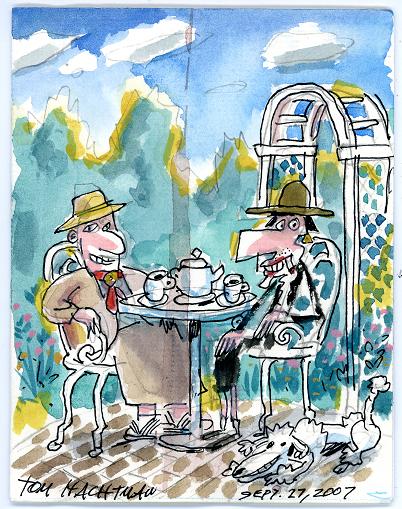
Articles on Animation 28 Sep 2007 07:58 am
A Couple of Early French Animators
- In 1981 there was a gallery showing in France celebrating the 100 years of French animation. They focused on a number of celebrated names. I have a copy of the catalogue and thought it might be a good idea to translate a couple of the pages and feature a couple of these French masters. I hope to feature more in future posts. These two are the ones I’ve heard about my whole life. Halas made them both stars with his Technique of Film Animation.
Born in Hungary, Jean Image (pseudonym of lmre Hajdu) emigrated to France in 1932 and worked in advertising prior to World War II. He was located in the southern zone during the German occupation of France.
His first films included the shorts, Les Noirs Jouent et Gagnent (1944) and The Adventures of Monsieur Pinceau. His films opened in the unoccupied zones and moved onto Paris after the Liberation. The film Saturn Rhapsody (1946) was selected for the Cannes Film Festival.
Image became the most prolific French producer-director doing both animated short films and features. (Jeannot the Intrepid in 1950, Bonjour Paris in 1952, etc). He was one of the first in France to produce several series for television, such Joe and the Bees (1960-1962) and Kiri the Clown (1966-1969). He was unquestionably a popular figure. In his late films, he worked in collaboration with his wife, France Image, who wrote scripts.
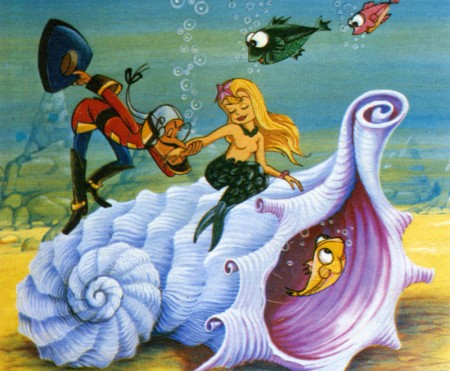
The Adventures of Baron Munchausen
French animation still sought a style of its own when the company “Gemini” was established by André Sarrut and Paul Grimault in 1936.
Their first films reflect the original talent of Grimault combined with an organized production which was often lacking in France.
The team patiently trained animators around Grimault and led the industry thereafter and for many years. Artists such as Lacam, Allignet, Dubrisay, Dupont, Genestre, July, Landrot, Leroux, Mutschler, Ruiz, Vausseur, Watrin, etc, became the elite of French animation.
Grimault’s first film to receive International acclaim was Le Passagers de la Grande Ourse in 1942. (See my separate post about this film.)
Paul Grimault was the winner of the 1st Emile-Reynaud prize awarded in 1943 by film criticis for the body of his work. He was again awarded the Louis-Delluc prize for his full-length feature Le Roi et l’oiseau. Grimault had worked since 1945 to complete this film which was released by Sarrut in 1952 under the title, La Bergère et Le Ramoneur. This caused a great rift between Sarrut and Grimault. With his cohort and companion, Jacques Prévert, he was able to reclaim the film and complete the definitive version released in 1980.
In the interval, several short films were made under the of Grimault’s direction – Le Petit Soldat (1947), Voleur de Paratonnerres(1944), etc. – and more recently,
Le Diamant (1970), Le Chien Mélomane (1973) and La Table Tournante (1977).
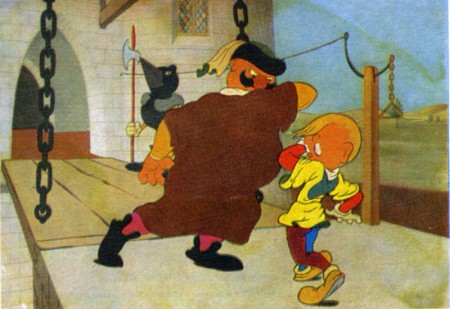
Le Marchand de Notes
Articles on Animation &Commentary 21 Sep 2007 07:41 am
French Oscar & Cinegram Zagreb
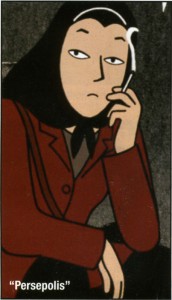 - An interesting game of politics is happening in this year’s Oscar race. Persepolis, which will obviously be eligible for the Best Animated Feature Award, has been chosen by France, the film’s native country, to represent France in the Best Foreign Film Award. A country is allowed to select only one film to represent itself for this award, and it’s an exciting development that it is representing France.
- An interesting game of politics is happening in this year’s Oscar race. Persepolis, which will obviously be eligible for the Best Animated Feature Award, has been chosen by France, the film’s native country, to represent France in the Best Foreign Film Award. A country is allowed to select only one film to represent itself for this award, and it’s an exciting development that it is representing France.
Sicne the creation of the Best Animated Feature Award, animators in the academy have come to realize that this not only gives animation a pat on the back but also isolates animated films from other categories. It’s as if they were saying, we’ve given you your own award, now why should we put you up for Best Picture (as only Beauty and the Beast has done in the past.) The animation ghetto seems to be opening up,if only a little, by France’s decision.
Good Luck to Persepolis in Ottawa. It played there on Wednesday. It will be the closing night film at the NY Film Festival on Oct. 14th. The film opens, nationwide, on Dec. 25th.
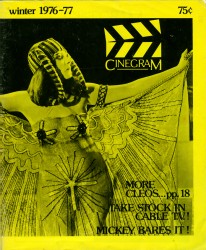 – I recently posted an article on the history of Mickey Mouse straight from the pages of Cinegram Magazine, a small magazine published in the late ’70′s from the University of Michigan.
– I recently posted an article on the history of Mickey Mouse straight from the pages of Cinegram Magazine, a small magazine published in the late ’70′s from the University of Michigan.
In the issue, Winter 1976-77, there was a second interesting article about the Eastern European animation scene. This, of course, meant only one thing in 1976, Zagreb, a studio that had alreaday won the Oscar and was turning out exceptional art films that were getting a lot of attention on the world stage. The article is by Frank Beaver. He is a noted historian, critic and essayist on film, his publications include On Film: A History of the Motion Picture and 100 Years of American Film and Oliver Stone: Wakeup Cinema .
Here is his article on Zagreb films:
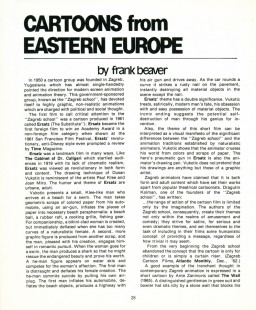
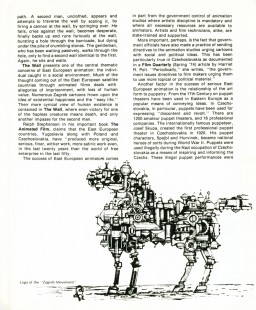
____ (Click any image to enlarge.)
Articles on Animation &Disney 19 Sep 2007 08:19 am
Cinegram – Mickey Mouse
 – Cinegram was a small magazine published in 1976-77 out of the University of Michigan. In one issue, winter 1976-77, there were two interesting articles of interest to animation enthusiasts. The first was on Eastern European animation, and by that they mean Zagreb. The second was on the history of Mickey Mouse, then approaching his Fiftieth anniversary.
– Cinegram was a small magazine published in 1976-77 out of the University of Michigan. In one issue, winter 1976-77, there were two interesting articles of interest to animation enthusiasts. The first was on Eastern European animation, and by that they mean Zagreb. The second was on the history of Mickey Mouse, then approaching his Fiftieth anniversary.
I’ve decided to put up both articles but feel that they are so unrelated to each other, that I’ll make two posts out of it. Probably of more interest to most is the article on Mickey Mouse, so that’ll start it off.
Note, of course, that this was written in 1976, and, as such, is dated. The author, Rick Shale, is now a teacher in the English Dept. at Youngstown University in Michigan.
Here, then, is this article:
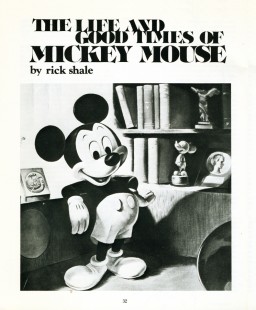
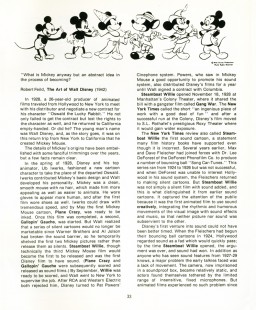
____ (Click any image to enlarge.)
Animation &Articles on Animation &Hubley 30 Aug 2007 07:49 am
Littlejohn & Tyer
- Bill Littlejohn is an animation “God” who doesn’t get the attention he deserves. Let me call your attention to an excellent and extensive interview Tom Sito conducted with Bill which is posted on AWN.
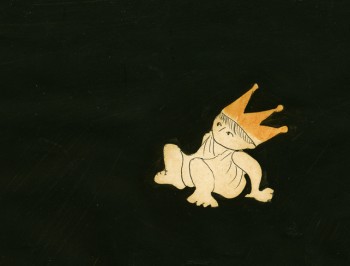 Bill was one of the first animators whose work I could identify opn screen. I studied the Hubley films in my early years, and I watched The Hole and Of Stars and Men every chance I could in the days before vhs tapes when you had to go to a theater to see these films.
Bill was one of the first animators whose work I could identify opn screen. I studied the Hubley films in my early years, and I watched The Hole and Of Stars and Men every chance I could in the days before vhs tapes when you had to go to a theater to see these films.
Bill’s work on Of Stars and Men has completely entered my vocabulary of great animation. The walk cycles for the many animals are just so magestic and regal that I watch them over and over.
That film employed the Hubley technique in which the animation drawings were painted black (using oil paint so that the paper wouldn’t buckle) all about the exterior of the character and were then double-exposed over the backgrounds. A lot of hit and miss was part of the process as characters had to avoid each other or create a multiple exposure; you could see through each of the levels. With each run through the camera, the density of the image kept thinning out, as well. It’s amazing how stunning this film is given the inherent problems in the technique. And it was made for a budget of $90,000 – a feature film!
I have a lot of Bill’s animation drawings I saved while working at Hubley’s. I’ll try to scan some soon.
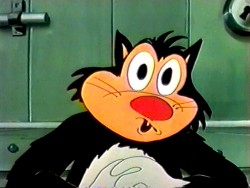 - There’s an enormous Jim Tyer post which celebrated his brithday back in February. there’s not much new information here, just a lot – and I mean lots – of links to videos and other writings. If you’ve a mania for Jim Tyer, this is the first stop.
- There’s an enormous Jim Tyer post which celebrated his brithday back in February. there’s not much new information here, just a lot – and I mean lots – of links to videos and other writings. If you’ve a mania for Jim Tyer, this is the first stop.
There are quite a few sites which break down Tyer films in a frame by frame analysis. His animation is good for this; the distortions are so entertaining. However, I sometimes wish there were more of a critical analysis by someone who is truly knowledgeable about animation. It’d be fun to see an informative comparison between some of Rod Scribner and Jim Tyer, but truly discuss their work in relation to animation technique. Less show-and-tell and more commentary with illustrations supporting the thesis. Maybe someday when I’m in a ponderous state, I’ll offer my thoughts. However, until then, it’s still fun to look at the wacky drawings.
A couple of these sites are:
Animation I.D. Tyer-How Does It Work
Classic Cartoons “How To Relax”
Classic Cartoons “Foiling the Fox”
Inspiration GrabBag More Jim Tyer
Articles on Animation &Hubley 06 Aug 2007 08:12 am
Cockaboody NYTimes
- Since I’ve been posting the storyboards for John & Faith Hubley‘s short, Cockaboody. I thought it might be a good time to post this short article featured in the NYTimes at the time the film was made.
By the way, if you haven’t seen it, you can watch Cockaboody on YouTube.
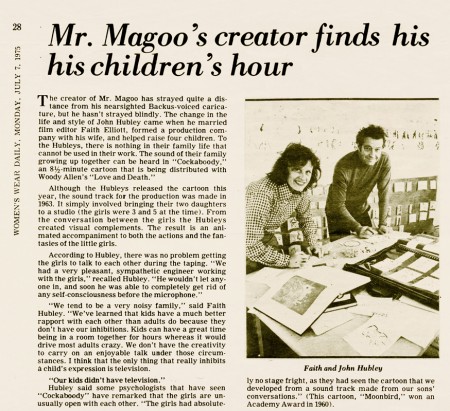
__________________________________ (Click images to enlarge.)
_____________________________
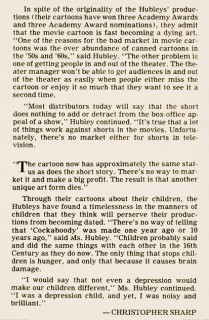 _____________________________
_____________________________

